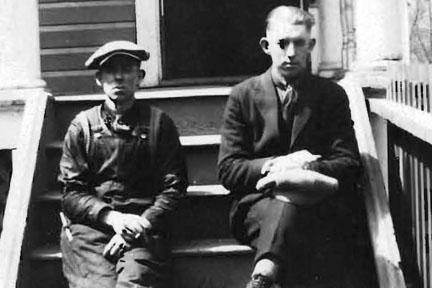
Percy Dickie (left) and his brother Earl, dressed for work.
These days, there is a certain amount of freedom in deciding what to wear. But it was not so long ago that there were certain universal expectations about what was appropriate attire for work and other social situations. Consider denim clothing, short pants and T-shirts or tank tops, for examples.
In the earlier days of the 20th century, denim clothing including trousers (pants) and overalls were considered barn clothes or work clothes of good durability for farmers and those in the manual trades. Percy Dickie, one of the DICKIES FROM GUNTON: CANADIAN BROTHERS IN TWO WORLD WARS, was a farmer and a plumber. Percy went to work in his overalls.
Grown men did not wear short trousers. Young boys wore them until they graduated to long ones. These short trousers were often called breeks.
Grown men did not wear T-shirts or tank tops, like we know them today. They wore undershirts, but like the name says, they were undergarments worn under a shirt.
Only on the beach, when planning to go for a swim, would a man wear something so minimalist that it looked like an undershirt and shorts in public. That was a bathing suit.
Men working in offices, businesses like banks and retail stores,dressed professionally. Even in the heat of summer when no air conditioning was available and indoor temperatures soared, employers insisted men wear trousers, long-sleeved shirts, a vest, jacket and tie, to project their company’s professionalism. Certainly some professionals fainted from the heat.
Men who went to do their banking or shopping, went to the movie theatre, and other places, also dressed much more formally than people do today. No barn clothes. Trousers and a long-sleeved shirt at the very least.
Women dressed more formally too. They wore dresses or a shirt and skirt, and ensured they were presentable by doing their hair and powdering their noses. In the downtown Winnipeg Hudson’s Bay store ladies room, there were rows of mirrors with lights where women could sit and freshen themselves up. The mirrors took up more space than the toilets and sinks.
Later, denim and overalls became more fashionable. Young people would wear them to school and out and about. Hemlines rose. Women started wearing trousers, and jeans, and yoga pants.
But in Percy’s day, no respectable man would be caught wearing anything less than appropriate attire at work or on the town. They did not need written rules or explanations. They just knew. It was understood.
